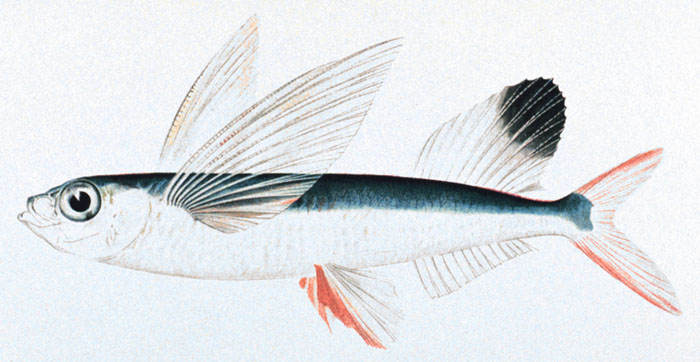- Flying fish are a group of marine fish known for their unique ability to glide through the air.
- They have elongated pectoral fins that act as wings, allowing them to leap out of the water and glide for significant distances.
- Flying fish are found in oceans and seas around the world, predominantly in warm tropical and subtropical regions.
- They have a streamlined body shape and a large, muscular tail that provides propulsion in the water.
- Flying fish have adapted to evade predators by using their gliding ability to escape from the water’s surface.
- They can reach impressive speeds in the air, gliding for up to 655 feet (200 meters) in a single flight.
- Flying fish use their powerful tails to propel themselves out of the water, aided by their specialized wing-like fins.
- They are capable of making rapid turns and adjustments in the air, allowing them to avoid obstacles and predators.
- Flying fish have a unique ability to control their flight path by adjusting the angle of their wing-like fins.
- They often travel in schools, using their gliding ability to migrate to different feeding grounds.
- Flying fish primarily feed on plankton and small organisms found near the water’s surface.
- They have large, bulging eyes that provide excellent vision both above and below the water.
- Flying fish have a range of colorations and patterns, helping them blend into their surroundings and evade predators.
- They are known for their exceptional jumping ability, propelling themselves out of the water using their muscular tails.
- Flying fish have been observed gliding for distances of over 1,300 feet (400 meters) in optimal conditions.
- They are agile and efficient gliders, using their pectoral fins to stay airborne for extended periods.
- Flying fish are not true fliers like birds or bats, as they rely on gliding rather than sustained powered flight.
- They have a streamlined body and reduced body weight, enabling them to remain airborne for longer durations.
- Flying fish can adjust the angle of their wing-like fins to change their flight trajectory and distance.
- They often travel in large groups, which provides protection and increases their chances of survival.
- Flying fish can reach heights of up to 20 feet (6 meters) above the water’s surface during their gliding flights.
- They are highly sensitive to vibrations in the water, allowing them to detect the presence of predators or potential threats.
- Flying fish are an important food source for various marine predators, including dolphins, seabirds, and larger fish.
- They have a unique reproductive behavior, with females releasing their eggs near the water’s surface and males fertilizing them externally.
- Flying fish have been observed to glide in a “zigzag” pattern, which helps confuse predators and increase their chances of escape.
- They are not strong swimmers compared to other fish species, but their gliding ability provides an effective means of escape.
- Flying fish have been known to unintentionally glide onto boats or ships, often becoming stranded on deck.
- They are most active during dawn and dusk, utilizing low light conditions to increase their chances of evading predators.
- Flying fish have a lateral line system, which helps them detect changes in water pressure and movement.
- They are capable of reaching speeds of up to 37 miles per hour (60 kilometers per hour) during their gliding flights.
- Flying fish are not exclusive to saltwater environments and can also be found in some freshwater habitats.
- They have a keen sense of direction and can navigate using celestial cues such as the moon and stars.
- Flying fish are a popular food source in some cultures, known for their delicate flavor and tender meat.
- They have a rapid growth rate, reaching maturity within a year or two depending on the species.
- Flying fish have a lifespan of around four to five years on average, although this can vary depending on the species and environmental conditions.
- They are an important component of marine ecosystems, contributing to the transfer of energy and nutrient cycling.
- Flying fish produce a slimy substance called “viscous secretion” that helps reduce drag during their gliding flights.
- They have been known to glide in large numbers, creating a stunning spectacle as they soar above the water’s surface.
- Flying fish have been the subject of scientific study and research, providing valuable insights into their locomotion and ecological role.
- They have a remarkable ability to adjust their gliding technique based on environmental conditions, such as wind speed and wave height.
- Flying fish are capable of making controlled descents back into the water, using their tails to re-enter the marine environment.
- They are known to exhibit migratory behavior, traveling long distances to reach suitable breeding or feeding grounds.
- Flying fish have a unique organ called the “fourth branchiostegal ray,” which helps stabilize their bodies during gliding flights.
- They are not commonly kept in captivity due to their specialized needs and adaptations for an open ocean environment.
- Flying fish have inspired human inventions, with engineers and scientists studying their aerodynamics to improve aircraft design.
- They play a role in the carbon cycle by consuming carbon-rich plankton and other organisms near the water’s surface.
- Flying fish have a low reproductive output, with females typically releasing thousands of eggs during a single breeding season.
- They can detect changes in water temperature, which helps them navigate to areas with optimal conditions for feeding and reproduction.
- Flying fish are believed to have evolved their gliding ability as a survival strategy to escape from underwater predators.
- They are fascinating creatures that captivate the imagination, showcasing the remarkable adaptability and diversity of life in our oceans.
Facebook Comments


































